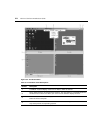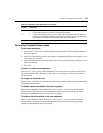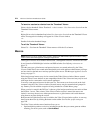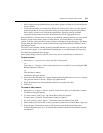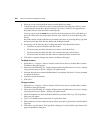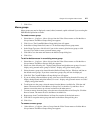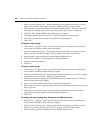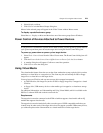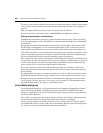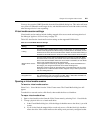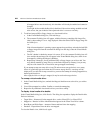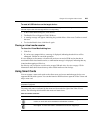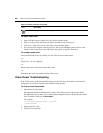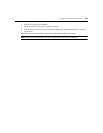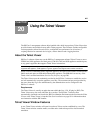
280 DSView 3 Software Installer/User Guide
The user (or user group to which the user belongs) must have permission to establish virtual media
sessions and/or reserved virtual media sessions to the target device. See About Access Rights on
page 144.
Only one virtual media session may be active to a target device at one time.
You may not use the virtual media feature with the DSR Remote Operations software.
Sharing and preemption considerations
The KVM and virtual media sessions are separate; therefore, there are many options for sharing,
reserving or preempting sessions. The DSView 3 software has the flexibility to accommodate the
system needs.
For example, the KVM and virtual media sessions may be locked together. In this mode, when a
KVM session is disconnected, so is the associated virtual media session. If the sessions are not
locked together, the KVM session can be closed but the virtual media session will remain active.
This could be desirable if a user is performing a time-intensive task using the virtual media session
(such as an operating system load), and wants to establish a KVM session with a different target
device to perform other functions while the operating system load progresses.
Once a target device has an active virtual media session without an associated active KVM session,
two situations can occur - the original user (User A) can reconnect or a different user (User B) can
connect to that channel. You may set an option in the Virtual Media dialog box (Reserved) that
allows only the User A to access that channel with a KVM session.
If User B is allowed to access that session (the Reserved option is not enabled), User B could
control the media that is being used in the virtual media session. In some environments, this may
not be desirable.
By using the Reserved option in a tiered environment, only User A could access the lower switch
and the KVM channel between the upper switch and lower switch would be reserved for User A.
Preemption levels offer additional flexibility of combinations. See Opening an exclusive KVM
session on page 252 and Connecting to an existing session on page 252. The preemption modes
described in those sections also apply to virtual media session.
Virtual Media dialog box
The Virtual Media dialog box is a program that manages the mapping and unmapping of virtual
media. The dialog box displays all the physical drives on the client’s workstation that can be
mapped as virtual drives. You may also add ISO and floppy image files and then map them using
the Virtual Media dialog box.
After a device is mapped, the Virtual Media dialog box Details View displays information about
the amount of data transferred and the time elapsed since the device was mapped.
You may specify that the virtual media session is reserved. When a session is reserved, and the
associated KVM session is closed, another user cannot launch a KVM session to that target device.
If a session is not reserved, another KVM session may be launched.



